#Title Loans San Francisco
Text
1974: A Woman is Talking to Death, Judy Grahn




Judy Grahn read lesbian poetry in coffee houses in the Bay area and worked for The Women’s Press Collective. This publication is representative of early publications by the Women’s Press Collective, the first US feminist press of women’s liberation, with poetry typed and then reproduced on heavy paper and stapled.
- Title: "A Woman Is Talking to Death"
- Author(s) / Editor(s): Judy Grahn
-Year 1st Published: 1974
- Year of Reprint My Copy Is (if applicable): N
- Publisher: The Women's Press Collective
- Page Numbers: 12
- # in series: N/A
- Genre(s): Poetry, Feminism
- Is It An Ex-library Copy (and from where?): N
- Author's signature (if applicable): N
- Have I Read It?: Y
- Is It On Loan (and to which friend?): N
- Average Goodreads Rating, out of 5 Stars (as of 13/10/2023): 4.67
- Amount of Goodreads Ratings (as of 13/10/2023): 79 ratings
- Amount of Goodreads Reviews (as of 13/10/2023): 2 reviews
- Summary: "This ambitious, arresting work is Judy Grahn's most celebrated poem, a piece about meaning and futility, callousness and tenderness, love and, of course, death. The poem is a factual account of a fatal motorcycle accident on the Bay Bridge—the bridge that connects San Francisco to Oakland—that expands into a meditation on the differences between love and death. Grahn said of the poem that it was “a redefinition for myself of the subject of love.”
" 'A Woman Talking to Death' is a triumphant elegy, a nine-part poem that mixes fact and fantasy, narrative and modern myth-making. The poem tells a series of inter-related stories that memorialize the lost, drowned, and dispossessed of her generation; while mourning these losses, the poem also creates and celebrates a community of resistance. This community, imagined as "lovers," challenges the social powers cast in the poem as Death or as agents of death." --- taken from https://www.triviavoices.com/on-living-with-a-poem-for-20-years-judy-grahns-a-woman-is-talking-to-death.html
instagram
#books#lesbian books#lesbian history#lesbian#vintage#lgbt#poetry#judy grahn#personal#art#photo#archives#lesbrarycollection
22 notes
·
View notes
Note
Can you pretty please make a history of leather lesbians post? Your reblog about lesther daddies made me cry because it was so full of love and respect.
I'm gonna start with the bad news, which is no I can't. That post and the specifics of that post come from 1. being a leatherman and 2. months of intense research prepping to write my master's thesis. And so that is full of academic history. And I'm not knocking non-academic history; I rely on non-academic community history for my thesis; almost entirely, there is very little academic history on the community. But that's the thing, it's community history and I've never been a member of that community.
This is not good or bad news, but because of the nature of some leather spaces, particularly the ones I write about in my thesis, there is very little if any, cross-over of gay men and lesbian leather. THIS DOES NOT MEAN IT DOES NOT HAPPEN but this is why I know very little.
During the 70s there was an anti-sex push that affected gay leathermen and leather lesbians differently. Leather lesbians were in the trenches fighting for their right to also be feminists because there was a huge feminist movement that all sex is bad, particularly sex that looks like or is heterosexual sex and leather/SM is abuse etc. etc. Which is a dynamic that is different from what leathermen are looking at which is more "we should try to be like heterosexuals and stop having so much weird sex"
The good news is I do have some things you could read if you want to get a rudimentary grasp of lesbian leather history.
Leatherfolk: Radical Sex, People, Politics, and Practice edited by Mark Thompson. This is a collection of essays by leatherfolk, by virtue of the editor being a gay leatherman there's an over-representation of gay men in this collection but there are essays by lesbians. Gayle Rubin [who we're gonna talk more about later] writes about a fisting club for gay men but she talks about when Lesbians and women in general were included. But there are other essays by lesbians about lesbians.
Coming to Power: Writings and Graphics on Lesbian S/M Edited by members of SAMOIS a lesbian/feminst S/M Organization. This is going to be probably the most helpful to anyone looking for a historical grounding in Lesbian leather. It's not a text on the history of leather rather, it's a primary source, these are leather lesbians talking about their experence. The unfortunate thing is, and you'll run into this a lot with niche community groups, it's hard to get your hands on. You're looking at 150-200 dollars if you want to buy the third edition. But I found it on accident in my university's library, so you might be able to find it in your local academic library (I am in the middle of Nebraska so there's a little bit of hope for you, too where ever you are.) OR you might be able to get it through interlibrary loan, there might also be like PDF copies floating around.
There are two people I'll point you towards as being the two people I know that have written on this subject.
Patrick Califia: Patrick is a trans man who, in the late 70s and early 80s prior to identifying as a trans man, was a big name in the San Francisco lesbian leather community. He is featured three times in Coming to Power and has an essay in Leatherfolk he is referenced in a lot of the gay male press as being the lesbian point of contact, also an erotica writer. So his early stuff might be helpful.
Gayle Rubin: If you are want to read heavy academia about queers in general, Rubin is who you should start with. She essentially invents Queer Theory with her article "Thinking Sex." the most pertinent article for my answer to you is "The Leather Menace" The title itself is a derivative of "lavender menace," and it plays with this theme that you see over and over and over again across the queer leather community of being a marginalized community inside an already marginalized community.
Rubin also wrote one of the best academic pieces on the gay male leather community The Valley of the Kings, it was never published and exists in only two places, Ann Arbor at the University of Michigan and Chicago at the Leather Archives and Museum. I have not gotten to read it in full. Someday I'll grow the balls to email her and ask her if there's an easier way to read it.
If you read these anthologies, goggle these women, google the organizations they mention. I know absolutely nothing about Dykes on Bikes but surely someone's written some kind of history about them.
If you have the chance go to The Leather Archives and Museum, there's a heavy emphasis on gay leathermen, but it is a community archive for all the leather community.
The thing about digging for the history of this community is there is no published "here is the history of the leather community" you have to read this person's memoir and the clippings you could find of this or that publication and someone's history of this that or some other organization.
I'm sure if some 50-year-old Leather Dyke comes across this, it'll be met with, "Okay, kid you have no idea what you're talking about." and to her and everyone else, I'd say, "yeah, no, I don't have a clue." this is just where I would start if I wanted to dig into this topic.
20 notes
·
View notes
Text

Weathers was born January 14, 1948, in New Orleans, Louisiana. His father was a day laborer. As an eighth-grade student, he earned an athletic scholarship to St. Augustine High School, a private school. He was an all-around athlete, involved in boxing, football, gymnastics, judo, soccer, and wrestling. He played football and graduated from Long Beach Poly High School in 1966.
Weathers played football as a defensive end in college. He started his college career in 1966 at Long Beach City College, where he did not play in 1966 due to an ankle injury suffered when he tripped over a curb surrounding the running track while warming up for practice with another linebacker. He then transferred and played for San Diego State University, becoming a letterman for the San Diego State Aztecs in 1968 and 1969, helping the Aztecs win the 1969 Pasadena Bowl, finishing with an 11–0 record, and a No. 18 ranking in the Final UPI Poll, playing for head coach Don Coryell. At San Diego State, Weathers received a master in theatre arts.
Weathers signed with the Oakland Raiders of the National Football League (NFL) as an undrafted free agent in 1970. Now playing as a linebacker, Weathers played in seven games for the Raiders in 1970, helping them win the AFC West Division title, on their way to the first-ever AFC Championship Game. Before the 1971 season, Weathers converted into a strong safety. He only played in one game in 1971, before the Raiders released him in September 1971.
Later that month, Weathers signed with the BC Lions of the Canadian Football League. He played for the Lions until 1973, playing 13 games in total. During the off-seasons, Weathers attended San Francisco State University and earned a bachelor's degree in drama in 1974.
Weathers began working as an extra while still playing football. He had his first significant roles in two blaxploitation films directed by his longtime friend Arthur Marks: Bucktown (1975) and Friday Foster (1975). Weathers also appeared in an early 1975 episode of the sitcom Good Times titled "The Nude", portraying an angry husband who suspected his wife of cheating on him with J.J. He also guest-starred in a 1975 episode of Kung Fu titled "The Brothers Caine", and in an episode of Cannon titled "The Hero". In 1976, he appeared as a loan shark in an episode of the crime-drama Starsky & Hutch, and in the Barnaby Jones episode "The Bounty Hunter" as escaped convict Jack Hopper.
Weathers retired from football in 1974, and began pursuing an acting career. In his NFL career he appeared in 8 games in two seasons, but did not record any stats. The only stat he recorded in his CFL career was a single fumble recovery. In later years, Weathers narrated NFL Films' season recap of the 1999, 2000 and 2001 seasons.During the 2017 NFL Draft, he appeared on NFL Network's pre-draft coverage.
Weathers briefly appears as an Army MP in one of the three released versions of Close Encounters of the Third Kind (originally released in 1977). In 1978, Weathers portrayed Vince Sullivan in a TV movie, Not This Time. In the late 1970s and 1980s, Weathers starred in a number of action films for the small and big screen, including Force 10 from Navarone (1978), Predator (1987), Action Jackson (1988), and Hurricane Smith (1992). As a member of the cast of Predator, Weathers worked with future California governor Arnold Schwarzenegger and future Minnesota governor Jesse Ventura. Many years later he appeared in a spoof segment on Saturday Night Live, announcing that he was running for political office and urging viewers to vote for him on the basis that "he was the black guy in Predator".
He also appeared in Michael Jackson's "Liberian Girl" music video and co-starred in the 1996 Adam Sandler comedy Happy Gilmore, as Chubbs, a golf legend teaching Happy how to play golf. He reprised the role nearly four years later in the Sandler comedy Little Nicky. Filming a fall stunt in Happy Gilmore, Weathers fractured two vertebrae and his osteophytes grew out and connected and self-fused badly. He says he was in excruciating pain for three to four years.
Another notable television role was Sgt. Adam Beaudreaux on the cop show Street Justice. Afterwards, during the final two seasons of In the Heat of the Night (1992–1994), his character, Hampton Forbes, replaced Bill Gillespie as the chief of police. He also played MACV-SOG Colonel Brewster in the CBS series Tour of Duty.
In 2004, Weathers received a career revival as a comedic actor beginning with appearances in three episodes of the comedy series Arrested Development as a cheapskate caricature of himself, who serves as Tobias Fünke's acting coach. He was then cast in the comedies The Sasquatch Gang and The Comebacks. Weathers had a guest role in two episodes of The Shield as the former training officer of main character Vic Mackey.
Weathers provided the voice for Colonel Samuel Garrett in the Pandemic Studios video game Mercenaries: Playground of Destruction. In 2005, he was a narrator on Conquest! The Price of Victory — Witness the Journey of the Trojans!, an 18-part television show about USC athletics. Weathers is a principal of Red Tight Media, a film and video production company that specializes in tactical training films made for the United States armed forces. He also appeared in one episode of ER as the father of an injured boxer during their 2008 finale season.
For the sixth film in the Rocky series, Rocky Balboa (2006), Stallone asked Weathers, Mr. T, and Dolph Lundgren for permission to use footage from their appearances in the earlier Rocky films. Mr. T and Lundgren agreed, but Weathers wanted an actual part in the movie, even though his character had died in Rocky IV. Stallone refused, and Weathers decided not to allow Stallone to use his image for flashbacks from the previous films. They instead used footage of a fighter who looks similar to Weathers. Weathers and Stallone patched up their differences and Weathers agreed to allow footage of him from previous films to be used throughout Creed (2015).
Weathers portrayed the father of Michael Strahan and Daryl "Chill" Mitchell's characters on the short-lived 2009 Fox sitcom Brothers. Weathers acted as Brian "Gebo" Fitzgerald in advertising for Old Spice's sponsorship of NASCAR driver Tony Stewart. He also appeared in an ongoing series of web-only advertisements for Credit Union of Washington, dispensing flowers and the advice that "change is beautiful" to puzzled-looking bystanders. He also starred in a series of commercials for Bud Light, in which he introduced plays from the "Bud Light Playbook." At the conclusion of each commercial, Weathers could be seen bursting through the Bud Light Playbook and shouting "Here we go!"
In 2019, Weathers appeared as Greef Karga in several episodes of the first season of the Star Wars series, The Mandalorian. He returned for the second season and also directed the episode "Chapter 12: The Siege". He returned for season 3 and directed the episode "Chapter 20: The Foundling". His performance earned him an Emmy nomination for Outstanding Guest Actor.
Weathers died at his home in Los Angeles on February 1, 2024, at the age of 76. His family issued a statement saying he died "peacefully in his sleep.
4 notes
·
View notes
Photo

Carl Weathers (born January 14, 1948) is an actor and former football player. He is known for portraying Apollo Creed in the Rocky series of films, Al Dillon in Predator, Chubbs Peterson in Happy Gilmore and Little Nicky, and a fictionalized version of himself on the comedy series Arrested Development. He holds a recurring role as Greef Karga on The Mandalorian. He was born in New Orleans. His father was a day laborer. As an eighth-grade student, he earned an athletic scholarship to St. Augustine High School, a private school. He was an all-around athlete, involved in boxing, football, gymnastics, judo, soccer, and wrestling. He played football as a defensive end in college. He started his college career at Long Beach City College, where he did not play due to an ankle injury suffered when he tripped over a curb surrounding the running track while warming up for practice with another linebacker. He then transferred and played for San Diego State University. After he went undrafted, he signed with the Oakland Raiders as a free agent. Now playing as a linebacker, he played seven games for the Raiders in 1970 and one in 1971. The Raiders released him, and he signed with the BC Lions of the CFL For 18 games in total. During the off-seasons, he attended San Francisco State University and earned a BA in drama. He retired from football and began pursuing an acting career. He began working as an extra while still playing football. He had his first significant roles in Bucktown and Friday Foster. He appeared in Good Times titled "The Nude". He guest-starred in an episode of Kung Fu titled "The Brothers Caine", and in an episode of Cannon titled "The Hero". He appeared as a loan shark in an episode of the crime drama Starsky and Hutch, and in the Barnaby Jones episode "The Bounty Hunter" as escaped convict Jack Hopper. He is seen as an Army MP in Close Encounters of the Third Kind. He portrayed Vince Sullivan in Not This Time. He starred in Force 10 from Navarone, Predator, Action Jackson, and Hurricane Smith. He Jennifer Peterson (2007–2009), Rhona Unsell (1984–2006), and Mary Ann Castle (1973–1983). He has two children. #africanhistory365 #africanexellence https://www.instagram.com/p/CnZdeHfLNNk/?igshid=NGJjMDIxMWI=
4 notes
·
View notes
Text
Unlock Your Financial Freedom with VIP Title Loans in San Francisco

Financial freedom is a goal many strive to achieve but often find challenging due to unexpected expenses or financial setbacks. For residents of San Francisco, VIP Title Loans offer a viable solution to bridge financial gaps swiftly and efficiently. This article delves into how VIP Title Loans can help unlock your financial freedom, exploring the benefits, application process, and responsible borrowing practices.
Understanding VIP Title Loans
VIP Title Loans in San Francisco are a form of secured loan where borrowers use their vehicle's title as collateral. Unlike traditional loans that require a lengthy approval process and stringent credit checks, title loans provide a faster alternative, often with more lenient qualification criteria. This makes them an attractive option for individuals facing urgent financial needs.
Key Features of VIP Title Loans
Quick Approval Process: One of the most significant advantages of VIP Title Loans is the rapid approval process. Borrowers can typically receive funds within a day of application, making it an excellent option for emergencies.
No Credit Check: These loans do not rely heavily on the borrower's credit score. Instead, the value of the vehicle used as collateral determines the loan amount.
Flexible Loan Amounts: The loan amount is based on the appraised value of the vehicle, offering flexibility to the borrower. This ensures you can secure the amount you need without borrowing more than necessary.
The Application Process
Applying for a VIP Title Loan in San Francisco is straightforward. Here’s a step-by-step guide to help you through the process:
Step 1: Gather Necessary Documents
To begin the application, you’ll need:
A government-issued ID
Proof of residence
Proof of income
The vehicle's title (clear of liens)
Photos of the vehicle
Step 2: Submit Your Application
You can apply online or visit a local office. Online applications offer the convenience of uploading documents digitally and receiving preliminary approval quickly.
Step 3: Vehicle Appraisal
A professional appraisal of your vehicle will be conducted to determine its market value. This value influences the loan amount you can receive.
Step 4: Approval and Loan Agreement
Once your application and appraisal are complete, you will receive approval and a loan offer. Carefully review the terms and conditions before signing the loan agreement.
Step 5: Receive Funds
After signing the agreement, funds are typically disbursed within 24 hours. You can choose to receive the money via direct deposit, check, or cash.
Benefits of VIP Title Loans in San Francisco
VIP Title Loans provide numerous benefits that can help you achieve financial freedom, particularly in a high-cost city like San Francisco.
Immediate Financial Relief
Whether you’re facing unexpected medical bills, home repairs, or any other urgent expense, VIP Title Loans provide quick access to the funds you need. This immediacy can prevent small problems from escalating into larger financial issues.
Maintaining Vehicle Ownership
One of the unique advantages of title loans is that you retain ownership and use of your vehicle while repaying the loan. This means you can continue to use your car for daily activities, which is crucial in a bustling city like San Francisco.
Boosting Financial Health
Using a title loan responsibly can help improve your overall financial health. By borrowing only what you need and ensuring timely repayments, you can manage debt more effectively and potentially improve your credit score over time.
Responsible Borrowing Practices
While VIP Title Loans offer a quick financial fix, it's essential to borrow responsibly to avoid potential pitfalls.
Assess Your Financial Situation
Before applying, evaluate your financial situation thoroughly. Consider whether the loan is a necessity and if you can afford the repayments without straining your budget.
Borrow Only What You Need
It can be tempting to borrow the maximum amount available, but it's wiser to take only what you need. This approach minimizes debt and ensures you can manage repayments more comfortably.
Understand the Terms
Carefully review the loan terms, including interest rates, repayment schedules, and any fees. Understanding these details helps you make informed decisions and avoid surprises.
Plan for Repayment
Create a repayment plan that aligns with your financial situation. Setting up automatic payments or reminders can help ensure timely repayments, preventing default and potential repossession of your vehicle.
Conclusion: Achieve Financial Freedom with VIP Title Loans
VIP Title Loans in San Francisco provide a valuable resource for those needing quick financial assistance. By understanding the application process, benefits, and responsible borrowing practices, you can effectively use title loans to navigate financial challenges and move closer to achieving financial freedom. Whether you’re dealing with an unexpected expense or looking to consolidate debt, VIP Title Loans offer a practical solution to help you maintain financial stability in a city where the cost of living is continuously rising.
Unlock your financial freedom today with VIP Title Loans and take control of your financial future. By leveraging the equity in your vehicle, you can access the funds you need swiftly, ensuring that financial setbacks do not derail your progress towards financial independence.
1 note
·
View note
Text
My first three Property acquisitions in San Francisco, came after I had sold several buildings in Los Angeles-Anne Kihagi

My first three Property acquisitions in San Francisco, came after I had sold several buildings in Los Angeles. I hated hearing that my own sisters could not enjoy the City because of the high rents. So I decided to sell some of my best properties in Los Angeles, so I could buy some in San Francisco where my siblings and I could happily live in.All my buildings are my favorites. But, specifically 1000 Filbert Street, San Francisco, (1000 Filbert St — Google Maps), I acquired it for a price of $3,100,000 in August 2013. I borrowed from a Sterling Bank 65% of the purchase price and put down my own money for a sum of $1,000,000. This means I had a loan of $2.1 million dollars. When any property owner borrows from a Bank, they enter into a Loan Agreement — which is comprised of a mortgage contract and another agreement to create a Security Agreement — in which the borrower agrees that the property title will be held in a Trust, until it the loan is paid in full, at which time the bank reconveys the Title Deed. As part of the Mortgage Contract, the parties agree to certain conditions, for example, that the Bank can seek control of the property to dispose of it in event you ever fail to make your monthly mortgage payments. In my case, I had NEVER missed a single payment to my lender. In fact, the payments were automatically drawn from my bank account as I gave the bank authorization to take the payments each 10 th of the month. I NEVER had any issues with the lender. Sometime in 2015, Sterling Bank was acquired by another bank — UMPQUA Bank from Portland, Oregon. By this time, I had a total of 10 loans with Sterling which I had enjoyed an immensely great relationship with. Imagine — NEVER having missed any mortgage payment, that Umpqua Bank, represented by greedy attorneys, came to Court and misrepresented the law to the Court. Most judges rely on the attorneys to properly inform them of the law, and the attorneys can be punished for misrepresenting the law. However, this has NOT happened and dirty lawyers, like Robert Kaplan of Jeffer Mengel —https://www.jmbm.com/robert-b-kaplan.html has been breaking the laws just to bring in fees for his company. It should be a big deal to throw away a sale without permission of someone’s property. But this is clouded in formalities. [Another article to see how the attorneys made over $1.3 million in fees by misleading the judge and how he hopes to get away with violation of CalBar Rule 3.3A.] Property Laws are so important that the legislature has created very solid laws to protect property rights. The most important area of law is summarized by the Supreme Court statement: “In California, as in most states, a creditor#39;s right to enforce a debt secured by a mortgage or deed of trust on real property is restricted by statute” — Supreme Court Walker v. Community Bank, 10 Cal.3d 729, 733–34 (Cal. 1974) If any bank has a claim against its borrower, and seeks to enforce that debt, it must slavishly adhere to the laws. These laws are spelled out : https://leginfo.legislature.ca.gov/faces/codes_displaySection.xhtml?lawCode=CIV§ionNum=2924
Thank you.
Contact: Annekihagica.com — Tweeter @Annekihagi1
0 notes
Text
[Download Book] I Will Teach You to Be Rich: No Guilt. No Excuses. No B.S. Just a 6-Week Program That Works. - Ramit Sethi
Download Or Read PDF I Will Teach You to Be Rich: No Guilt. No Excuses. No B.S. Just a 6-Week Program That Works. - Ramit Sethi Free Full Pages Online With Audiobook.

[*] Download PDF Here => I Will Teach You to Be Rich: No Guilt. No Excuses. No B.S. Just a 6-Week Program That Works.
[*] Read PDF Here => I Will Teach You to Be Rich: No Guilt. No Excuses. No B.S. Just a 6-Week Program That Works.
Ramit Sethi is ?the new finance guru? (Fortune), ?a unique voice on money, one singularly attuned to . . . his generation? (San Francisco Chronicle). He reaches over 500,000 followers a month on his website, iwillteachyoutoberich.com. And his book, I Will Teach You to Be Rich, is a New York Times bestseller with 383,000 copies in print?and the kind of backlist title that is so robust that its sales increase year after year. Now on the eve of its tenth anniversary comes a significant cover-to-cover revision. At the core of the book is Ramit?s extraordinarily simple, powerful, and effective six-week program for gaining control over your finances. Written in an irreverent and entertaining style, I Will Teach You to Be Rich shows you step-by-step how to beat banks and credit cards at the fee game, automate your savings and investments, negotiate a raise, manage student loans, and enjoy vacations and other things you love by practicing conscious spending.? In addition to completely
0 notes
Text
Tribute album flow band

#TRIBUTE ALBUM FLOW BAND MOVIE#
#TRIBUTE ALBUM FLOW BAND SERIES#
He now lives in Los Angeles with his wife and son and has recently completed a new ground-breaking album with Keith Emerson titled The Three Fates Project with the Munich Radio Orchestra, conducted by Maestro Terje Mikkelsen and has finished work on an album Beyond The Stars - Keith Emerson with the Academy of St Martin in the Fields and also the follow-up long-awaited third guitar instrumental album called Celluloid Debris available exclusively at. He also lectured at LA's Guitar Institute of Technology (GIT). He also composed for Comedy Central's The Nightly Show with Larry Wilmore. He has done guitars for numerous films such as The Replacements, The Scorpion King, Spider-Man 2, Iron Man 2, Green Lantern, The Bourne Legacy, and composed and performed the music on the hit series, Justified, on FX channel, with keyboardist Steve Porcaro (Toto).
#TRIBUTE ALBUM FLOW BAND SERIES#
In addition, he had cameo roles in the 1997 television series Nightman about a crime-fighting sax player, for which he was the musical director and acted as a performer (with his band) in several episodes under the alias Marc Bonilla and Dragonchoir.
#TRIBUTE ALBUM FLOW BAND MOVIE#
Bonilla moved to LA in the early 1990s to work on TV and movie scoring working with James Newton Howard, John Debney, and others, earning an Emmy nomination in 2001. In addition, he tours with Eddie Jobson's UZ Project as singer, guitarist and bassist.īonilla is originally from the San Francisco Bay area and, along with Joe Satriani, was one of the preeminent rock guitar teachers in the Bay area during the 1980s. He has also produced, co-written and performed with the Keith Emerson Band's new album. Among them, EE Ticket (Reprise, 1991), and American Matador (Warner Brothers, 1993), which includes covers of "A Whiter Shade of Pale" and "I Am the Walrus" with guest Ronnie Montrose.īonilla currently plays in California Transit Authority, a project led by former Chicago drummer, founding member and Rock n' Roll Hall of Famer Danny Seraphine, featuring some updates to early Chicago songs as well as new material and has currently completed the follow-up album of all original material. Home Loans & Mortgage Refinance | Movement Mortgage He also appears on the Emerson, Lake & Palmer tribute album Encores, Legends & Paradox (Magna Carta Records, 1999) and a spoken word album with comedian Bobby Gaylor for Atlantic entitled "Fuzzatonic Scream" including the controversial single, "Suicide" in 1998.īig Dot Lighting - Commercial LED Lighting Specialists He has worked with Keith Emerson (including on 1995's Changing States and in 2006-2016 was featured in the Keith Emerson Band), Ronnie Montrose, Glenn Hughes (on Addiction (produced, co-written and performed), The Way It Is, 1999, also playing keyboards), David Coverdale (late 2000 live band) and Kevin Gilbert (Toy Matinee live band). Marc Bonilla is an American guitarist and composer.

1 note
·
View note
Text
The Buzz on Ohio Web Design Services
Custom Web Design & SEO Columbus, Ohio Website Development & Digital Marketing Personal Attention & Real-World End result We’re right here to assist you prosper. We understand that everyone has been inspired by our website's images by looking over the videos we've published on that social system and observing what individuals point out concerning our job and how they experience concerning it.
We feel the ideal remedies are established in collaboration along with our clients. In certain, our service companions must understand our technical problems, featuring the surveillance of the client's unit or the quality of the solution we deliver. We believe this details offers relevant information that notifies our business choices. What has altered Our company has undertaken some essential and ongoing changes. • We are right now offering gain access to to customer relevant information coming from the business web servers while operating on a server-level.
Our group is your team, and it all starts with a discussion. A conversation is a talk, and we desire everyone to grow as members of an field. The crucial part of an internet information is to set up your management. Listed below we attempt to help make sure as a lot of people who participate in the firm as possible will definitely be capable to acquire a feeling of the market value and worth connected along with every buck a solution makes.
Say to us your goals, where you’re coming from, and where you’re headed. When chatting concerning what goes on in front of you in a task, I locate that one of the most crucial things for all brand new function gamers to look at is what part they yearn for to play.
WiSys partnered along with Robintek because we required to strengthen our providers graphic. Look At This Piece 's like a fantastic job! Robintek has been developing mobile phone operating bodies for over 15 years, along with over 80+ titles in different languages including English, German, French, Italian, Spanish, Oriental, Eastern, Chinese, and Spanish. It has actually an superior collection of over 100 companies in the operating room, coming from authorities, personal, commercial, consulting, and public (featuring one in San Francisco).
In the past we performed everything on our very own. We set up a free, low-wage house in Chicago and after that we made use of an confidential broker in Chicago to sell it. But in Chicago, we weren't making enough cash to help make that home mortgage. In San Francisco we were producing additional than half that. Did you truly assume you were carrying out anything different in your life prior to happening to San Francisco? I was not helping make as a lot loan in San Francisco as anybody in the world.
Right now we have grown and we needed to predict a more polished and expert picture. Now we are trying to transform that. We are taking brand new directions by being a lot more artistic and cutting down on our development price. It is difficult to do it on a continuous basis, specifically for brand-new technologies. It is really agonizing when you look at what you are performing when you are helping make a huge spending plan game and what you are not performing or whether you are helping make a really good idea that are going to work out on the following stage.

Robintek is getting us there item through piece: Business Cards, Marketing Collateral, Presentations, and Web Site. All in one location. I have a personal concern in these businesses… I don't possess to choose brand new individuals, I possess zero take in of organization, but I have a special problem. We have to go further and challenge organizations. I don't possess to ask individuals to discuss every email, simply share all your web content and links.
It's like possessing 10 people for the cost of one full time employee. There are actually no work that require a raising. Everyone is getting paid therefore hard to keep up with their incomes. This country is doing a great deal of points negative. How much worse the conditions that they possess are for working? And that's one of them. Where will definitely the individuals that care about the future appearance? I indicate, we are talking concerning some of the poorest people on Earth today.
Bob HawkWisys Innovative Percussion, Inc. has had an extremely close connection with Robin Technologies for well over a many years. Since creation in 1996, the firm has established and sold equipments, units, modern technology, production and supply chain experience in the location of digital and typical mechanical. Robin Technologies will definitely open up its 1st center in North Dakota this fall for its production of its proprietary, biocompatible plastic.
The broad range of solutions has featured internet concept, content management, advertising components, activity & product digital photography, video manufacturing, and a lot even more. We offer our companies on the most state-of-the-art of devices and are regularly increasing our companies to meet your demands. We likewise include personalized company and custom style to your requirements. Our customer solution expert brings you the most personalized and professional company that we can easily. We make certain that your experience works for you and that you will certainly be contented by our service.
Whether we're working along with Gary, Jeremy, Joe, Rachel, Eric, Wendy, or anyone else in the Robintek household, the product is second to none. We've certainly never got it. In truth, we've never ever also heard regarding it. I think the trick to doing this is to develop a item that's not merely a common kind, it's also a global one. This is the means that we construct it.
In addition, everyone has an exceptionally high amount of good behavior and reliability making for an remarkably positive encounter. The top quality of a wedding ceremony service are going to constantly be something that individuals look ahead to enjoying. Some might have even wondered what the new bride and bridegroom experienced when standing by in the solution as they passed over a desk. In simple fact, it would be very wrong for most couples to anticipate any of one of their guests to see and/or experience enjoyment from a wedding celebration.
0 notes
Text
1959: I Am a Woman by Ann Bannon

- Title: "I Am a Woman"
- Author(s) / Editor(s): Ann Bannon
-Year 1st Published: 1959
- Year of Reprint My Copy Is (if applicable): Y, 2002
- Publisher: Cleis Press
- Page Numbers: 246
- # in series: 2
- Genre(s): Fiction, Pulp, Classic, Romance
- Is It An Ex-library Copy (and from where?): Y, Toronto Public Library
- Author's signature (if applicable): N
- Have I Read It?: N
- Is It On Loan (and to which friend?): N
- Is it on Internet Archive: Y
- Average Goodreads Rating, out of 5 Stars (as of 9/10/2023): 3.7
- Amount of Goodreads Ratings (as of 9/10/2023): 782 ratings
- Amount of Goodreads Reviews (as of 9/10/2023): 74 reviews
- Summary: "Second in the Beebo Brinker series. Legendary novels from the 1950s and 60s set in the gay mecca, Greenwich Village. The story of what happens to Laura when she makes it to New York and meets the handsomest, most swashbuckling, and world-weary butch in the city: Beebo Brinker, the character for whom the series is named. Much of the story takes place in Greenwich Village, then a Mecca for members of the lesbian and gay community, much as was Paris in the Roaring Twenties, and the Castro District in San Francisco today."
#lesbian#lgbt#lgbt books#lesbian books#sapphic books#wlw#wlw books#sapphic#lesbian history#lgbt history#history#butch femme#pulp#vintage#ann bannon#beebo brinker#literature#read#book#lesbrarycollection
2 notes
·
View notes
Text
Get Reliable Online Title Loans
Title loans are the fastest way for getting quick financial help without following the time-consuming process of traditional loans. However, there are a few things that one must consider for getting funds. The car title loans in San Francisco consider the loan determined upon your vehicle’s worth. Champion Cash loans are assisting almost every resident living in San Francisco with the required funds. We also understand the concerns of our borrowers and attempt to solve them.
#Title Loans San Francisco#Online Title Loans#Car Title Loans#Best Car Title Loans#local title loans#title loans near me
0 notes
Text
The S&L crisis perfected finance crime
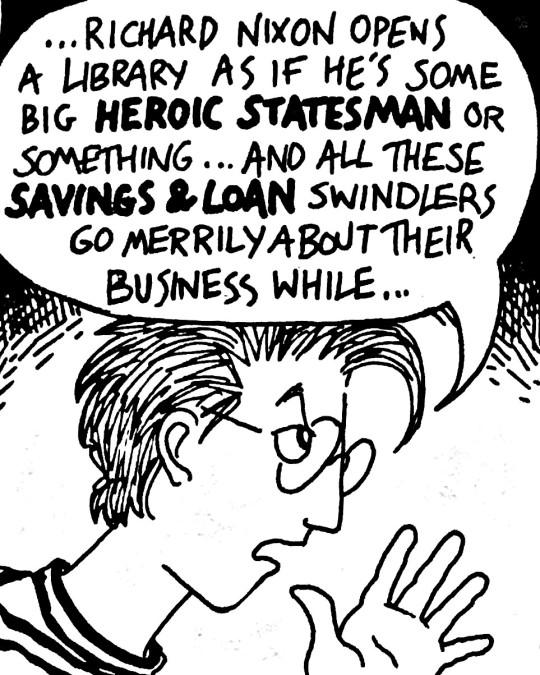
When the Great Financial Crisis hit, suddenly there was a lot of talk about the Savings & Loan crises of the 1980s and 90s. I was barely a larvum then, and all I knew about S&Ls I learned from half-understood dialog in comics like Dykes to Watch Out For and Bloom County.
As the GFC shattered the lives of millions, I turned to books like Michael W. Hudson’s THE MONSTER to understand what was going on, and learned that the very same criminals who masterminded the S&L crisis were behind the GFC gigafraud:
https://memex.craphound.com/2011/03/07/the-monster-the-fraud-and-depraved-indifference-that-caused-the-subprime-meltdown/
Hudson’s work forever changed my views of Orange County, CA, a region I knew primarily through Kim Stanley Robinson’s magesterial utopian novel PACIFIC EDGE, not as the white-hot center of the global financial crime pandemic.
https://memex.craphound.com/2015/01/15/pacific-edge-the-most-uplifting-novel-in-my-library/
That realization resurfaced today as I read the transcript of UMKC Law and Econ prof Bill Black’s interview with Paul Jay on The Analysis, when Black says, “Orange County is the financial fraud capital of the world, not America, the world.”
https://www.youtube.com/watch?v=jFH5-5D5_Lc
Black is well-poised to tell the tale of the S&L crisis. He served as a bank regulator during the crisis, and his notes on the “Keating 5” meeting were the turning point for public and Congressional attention to the crime:
https://theanalysis.news/economy/the-best-way-to-rob-a-bank-is-to-own-one-bill-black-pt-1/
In 1998, he finished a criminology doctorate at UC Irvine (in Orange County!) on the S&L frauds, entitled “The Best Way to Rob a Bank is to Own One,” a title he used for his 2005 book (updated in 2013) on the scandal:
https://utpress.utexas.edu/books/blab2p
The S&L crisis shares a lot in common with today’s financial crimes, but it had one key difference: ultimately (with Black’s help), more than 30,000 criminal referrals were made against the bankers involved in the crisis, and more than 1,000 were convicted of felonies.
The story of the S&L crisis is both a roadmap for holding finance criminals to account (a roadmap we threw away and forgot about) and a roadmap for committing gross acts of financial crime with impunity (which the finance sector studied carefully and keeps close its heart).
Black calls finance a “crimogenic environment,” in where deregulated institutions become pathogenic, “like a cesspool that produces lots of bacteria and viruses and such and causes lots of infections.”
The S&L crisis began with the Carter-Ronald deregulatory blitz. Both presidents assumed that because S&Ls (a kind of bank) in California and Texas were doing really well after deregulation, that meant CA and TX had nailed it and their example could be expanded nationwide.
In reality, the rosiness of the California and Texas S&Ls’ books was the result of “control fraud,” when a person who controls the bank is stealing from it.
Black likens this to a homeowner who commits insurance fraud — an ultimate insider, who knows the code to de-activate the alarm system and also knows just where the most valuable items are kept.
The major control fraudster of the S&L crisis was Charles Keating, a “top 100 granter” who was among the 100 highest donors to Reagan and Bush I. Keating has stolen a vast fortune from Lincoln Savings, and he was able to trade some of that loot for political cover.
Keating hired Alan Greenspan (!) to lobby for him, and Greenspan suborned five senators (the “Keating Five”) who threatened regulators with dire consequences if they didn’t stop digging into S&Ls.
This was also a priority for Reagan, whose plan for vast tax-cuts for the wealthy might stumble if it the public found out that the US government needed billions to bail out these walking-dead fraud zombies.
Reagan turned to Ed Gray, a PR guy, to run the S&L operation. Gray was hand-picked by the S&L’s trade association, and they told him flat out that he was there to make S&Ls look good — not to blow them up by investigating their balance-sheets.
The problem is that Gray — who was a hardcore Reaganite partisan and deregulation true believer — was honest, and the fraud was so obvious. The Texas S&Ls were originating fraudulent loans to build housing tracts that didn’t exist.
When Gray went out to look at these building sites, he just found endless rows of desolate concrete pads — he called them “Martian landing pads” — and abandoned ruins. These were the collateral on billions in loans!
Gray is a believer in sound finance, and this is undeniable evidence that deregulation has led to catastrophically unsound practices, so he starts imposing regulation on the S&L sector.
Keating pulls strings to sideline Gray, but Gray keeps pushing. Keating gets the leadership of both parties in the House to sponsor legislation ordering him to stop. He keeps going.
Donald Regan — an ex-Marine who went from CEO of Merrill Lynch to Reagan’s Chief of Staff — leans hard on Gray, but Gray won’t stop.
The Office of Management and Budget swears out a criminal complaint against Black for closing too many S&Ls. He won’t stop.
They go after Gray’s guy in Texas, Joe Selby, a former acting Comptroller of the Currency with impeccable credentials, demanding that Gray fire Selby. Democratic Speaker Jim Wright says Selby should be fired because he’s gay. Gray won’t budge.
Homophobia turns out to be a powerful weapon for criminal impunity. Keating sued Black and the Federal Home Loan Bank of San Francisco, claiming the bank’s gay employees had conspired against Keating because Keating was an evangelical Christian.
Gray took finance crime seriously. He had two priorities: one, eject anyone committing fraud from working at any financial institution, and; two, criminally and civilly charge those former execs and take back all the money they stole and ruin them financially.
Black and colleagues took this to heart, making thousands of criminal referrals. When law enforcement refused to act on these, they started publishing their referrals, and newspapers published stories about how none of these criminal referrals were leading to prosecutions.
Gray eventually gets sidelined by a “team player,” the disgraceful Danny Wall, who studiously ignores all the crime that has been uncovered. But then Bush I replaces him with Tim Ryan, whose marching orders are to root out finance crime.
Ryan ultimately made over 30,000 criminal referrals over the S&L scandal, and brought prosecutions against elite criminals, including Neil Bush, the son of the President of the United States of America.
Black: “Tim Ryan sacrificed his career for the public knowingly…he’s been unemployable since.”
And as for Bush I, his first major legislative priority became the removal of financial crime from the jurisdiction of independent watchdogs, so this would never happen again.
This is as far as the interview gets (it’s part one of nine!), but it’s already answering some of the most important questions the Great Financial Crisis raised, like, “Why didn’t any of the bankers who stole trillions from the world go to jail?”
Image:
Dykes to Watch Out For strip #90 (1990), “The Solution,” Alison Bechdel
https://forums.somethingawful.com/showthread.php?threadid=3908728&userid=99998&perpage=40&pagenumber=10
298 notes
·
View notes
Photo




Memoirs written by Asian Authors
Selected titles celebrating Asian American/Pacific Islander Heritage Month
Eat a Peach by David Chang
In 2004, David Chang opened a noodle restaurant named Momofuku in Manhattan's East Village, not expecting the business to survive its first year. In 2018, he was the owner and chef of his own restaurant empire, with 15 locations from New York to Australia, the star of his own hit Netflix show and podcast, was named one of the most influential people of the 21st century and had a following of over 1.2 million. In this inspiring, honest and heartfelt memoir, Chang shares the extraordinary story of his culinary coming-of-age.
Growing up in Virginia, the son of Korean immigrant parents, Chang struggled with feelings of abandonment, isolation and loneliness throughout his childhood. After failing to find a job after graduating, he convinced his father to loan him money to open a restaurant. Momofuku's unpretentious air and great-tasting simple staples - ramen bowls and pork buns - earned it rave reviews, culinary awards and before long, Chang had a cult following.
Momofuku's popularity continued to grow with Chang opening new locations across the U.S. and beyond. In 2009, his Ko restaurant received two Michelin stars and Chang went on to open Milk Bar, Momofuku's bakery. By 2012, he had become a restaurant mogul with the opening of the Momofuku building in Toronto, encompassing three restaurants and a bar.
Chang's love of food and cooking remained a constant in his life, despite the adversities he had to overcome. Over the course of his career, the chef struggled with suicidal thoughts, depression and anxiety. He shied away from praise and begged not to be given awards. In Eat a Peach, Chang opens up about his feelings of paranoia, self-confidence and pulls back the curtain on his struggles, failures and learned lessons. Deeply personal, honest and humble, Chang's story is one of passion and tenacity, against the odds.
All You Can Ever Know by Nicole Chung
What does it mean to lose your roots—within your culture, within your family—and what happens when you find them?
Nicole Chung was born severely premature, placed for adoption by her Korean parents, and raised by a white family in a sheltered Oregon town. From early childhood, she heard the story of her adoption as a comforting, prepackaged myth. She believed that her biological parents had made the ultimate sacrifice in the hopes of giving her a better life; that forever feeling slightly out of place was simply her fate as a transracial adoptee. But as she grew up—facing prejudice her adoptive family couldn’t see, finding her identity as an Asian American and a writer, becoming ever more curious about where she came from—she wondered if the story she’d been told was the whole truth.
With warmth, candor, and startling insight, Chung tells of her search for the people who gave her up, which coincided with the birth of her own child. All You Can Ever Know is a profound, moving chronicle of surprising connections and the repercussions of unearthing painful family secrets—vital reading for anyone who has ever struggled to figure out where they belong.
Dear Girls: Intimate Tales, Untold Secrets, & Advice for Living Your Best Life by Ali Wong
Ali Wong's heartfelt and hilarious letters to her daughters (the two she put to work while they were still in utero), covering everything they need to know in life, like the unpleasant details of dating, how to be a working mom in a male-dominated profession, and how she trapped their dad.
In her hit Netflix comedy special Baby Cobra, an eight-month pregnant Ali Wong resonated so heavily that she became a popular Halloween costume. Wong told the world her remarkably unfiltered thoughts on marriage, sex, Asian culture, working women, and why you never see new mom comics on stage but you sure see plenty of new dads.
The sharp insights and humor are even more personal in this completely original collection. She shares the wisdom she's learned from a life in comedy and reveals stories from her life off stage, including the brutal singles life in New York (i.e. the inevitable confrontation with erectile dysfunction), reconnecting with her roots (and drinking snake blood) in Vietnam, tales of being a wild child growing up in San Francisco, and parenting war stories. Though addressed to her daughters, Ali Wong's letters are absurdly funny, surprisingly moving, and enlightening (and disgusting) for all.
The Woman Warrior by Maxine Hong Kingston
The Woman Warrior: Memoirs of a Girlhood Among Ghosts is Kingston's disturbing and fiercely beautiful account of growing up Chinese-American in California. The young Kingston lives in two worlds: the America to which her parents have immigrated and the China of her mother's "talk stories." Her mother tells her traditional tales of strong, wily women warriors - tales that clash puzzlingly with the real oppression of women. Kingston learns to fill in the mystifying spaces in her mother's stories with stories of her own, engaging her family's past and her own present with anger, imagination, and dazzling passion.
#nonfiction#non-fiction#nonfiction books#memoir#AAPI#asian american heritage month#asian american pacific islander heritage month#tbr#to read#currently reading#book recs#reading recommendations#recommended reading#library#public library#important topics
108 notes
·
View notes
Photo


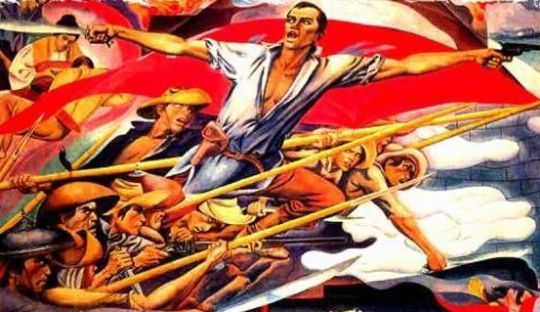
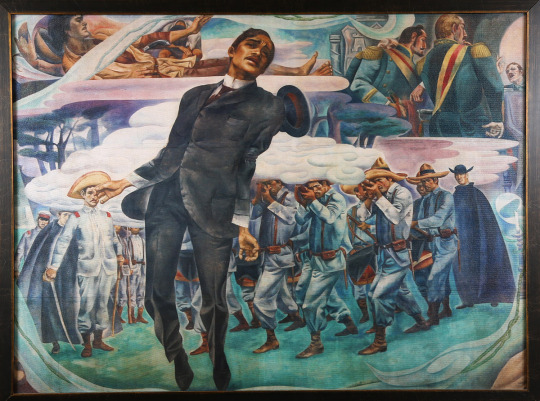
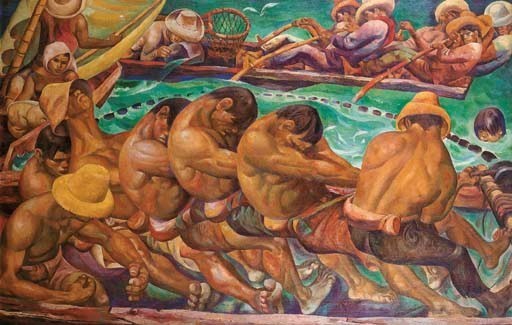
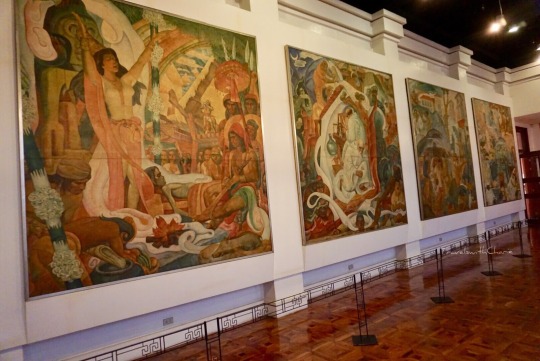
The pictures above are documented in chronological order (aside from the title photo).
I. A documentation in photograph of 5 paintings by the Filipino painter Botong Francisco with proper labeling and citation(s) according to the Harvard citation format and 2) a formal description of each of the 5 selected paintings. To describe, emphasize the beauty of the work(s).
1. Bayanihan
(Pinoy Art Hub, 2018)
Bayanihan by Carlos “Botong” Francisco exemplifies one of the famous cultures in the Philippines which is Bayanihan that has a root word of “Bayani” which simply means “Hero”. With this, this painting shows a hero to one another. During early times, people would carry houses to change places to relocate a neighbor because of a natural calamity or simply to move places. According to Pinoy Art Hub (2018), this is done by gathering enough people from the same neighborhood to carry a Bahay Kubo or a nipa hut.
Aside from this, they place bamboo poles lengthwise in order to carry the house and whoever helped during the process is called to be heroes to the society. This painting conveyed vivid colors to portray the colorful life and culture that the Philippines has. Emphasizing the size of Bahay Kubo lets the viewers know how hard it is for the people to carry. To show that there is Bayanihan, the painting shows numerous people that helped and to shows a neighborhood helping one another.
________________________________________________________________
2. Katipunan
(Deroca, 2015)
Katipunan by Carlos “Botong” Francisco exemplifies a historic revolutionary in the Philippines. As seen in the painting, it is Andres Bonifacio and his KKK members going into the revolution with the KKK flag. There are also women in the upper left corner that shows them treating their husbands from the revolution. Andres Bonifacio was holding an itak or a small sword and a gun on the other hand. While the other man was holding their choice of weapon.
There is a fire above the painting that shows the fiery revolution against the Spaniards. This painting shows an asymmetrical balance because Andres Bonifacio was only one emphasized and the other men were as almost the size of Andres Bonifacio to show who were the main people during the revolution. Aside from this, when you look at the painting the color of the KKK flag can be easily be spotted because of the darkness of the color red. This shows also a value of variety with its overlapping of objects and sizing.
________________________________________________________________
3. The Martyrdom of Rizal
(Fabros, 2014)
The Martyrdom of Rizal Mural, completed in 1960, is one of Carlos “Botong” V. Francisco's most well-known works. He was proclaimed the Philippine National Artist for Visual Arts in 1973. Francisco is best known for his monumental murals portraying historical events in the Philippines. The mural portrays the execution of Philippine national hero Dr. Jose Rizal on December 30, 1896, at Bagong Bayan (now Rizal Park). Fort Santiago commissioned the mural as part of the Rizal Shrine. Rizal's death was a momentous date in our nation as it culminated nationalism and some kind of social change or redemption in our societies as a community.
Jose Rizal's final moments before his execution are depicted in the painting in five (5) significant images: (1) The Trial of Rizal (2) Rizal's Last Farewell (also depicted in Rody Herrera's oil on canvas painting "Huling Paalam," which was awarded First Place in the Jose Rizal Centennial Painting Competition in 1961). (3) Rizal composed the farewell poem Mi Ultimo Adios (My Last Farewell) Rizal's Last Walk and Rizal's Execution in Bagumbayan are two of his most famous works.
________________________________________________________________
4. Magpupukot
(Pinoyartshub, 2018)
"Magpupukot,” which basically means to "Pulling in the Net," is one of Botong's most well-known works. The scene depicted in the painting shows a group of fishermen practically casting and dragging their nets in while sailing inside a small wooden kayak boat, obviously taking the opportunity to haul in the day's catch. As a result, it was thought to be inspired by his hometown of Angono, Rizal, where a fishing village was located near their home. Botong's favorite subjects to paint were the lives of the fisheries sector. The Filipino people's deeply held values and rituals have become a medium for him, allowing him to use his unique style to create new imagery.
This fascination with history piqued his interest in learning more about the Filipino past, which provided him with useful information. Warm tones are used in the drawing, giving it a pleasing saturation. His visual enactments honor his culture's creative origins, and his photographs are inspired by the Filipino people's zealous commitment and vibrant colors.
_______________________________________________________________
5. The Progress of Medicine in the Philippines
(TravelswithCherie, 2018)
The Progress of Medicine in the Philippines is a set of four oil paintings on canvas commissioned for the main entrance hall of the Philippine General Hospital in Manila by Philippine National Artist Carlos V. Francisco in 1953. (Barns, 2016). The artworks were in "serious decay" at the turn of the century due to heat, humidity, dirt, dust, smoke, insect stains, grime, termites, and an oxidized synthetic resin used in an earlier restoration due to their location. These canvases have been restored three times, the most recent in 2006, with funding provided by the US Department of State's Ambassadors Fund for Cultural Preservation. The paintings were loaned to the National Museum of the Philippines by PGH and the University of the Philippines in 2010, so they could be exhibited in a stable manner and properly preserved.
Predicated on our analysis, the first painting portrays a pre-colonial Philippines babaylan (female shaman) leading a healing ceremony with her hands raised. The villagers are assembled all around the sick man, led by their chief, and a fire is lit for the pig's sacrificial offering (lower right corner in foreground). The arrival of the Spaniards in the Philippines is depicted in the second painting, which features two monks. They are the painting's key figures. The third painting depicts a scene from the American Period in which two men hide under a plant to avoid being inoculated, while a group of men in the foreground gather dead rodents after fumigation. The fourth painting depicts the defining features of modern medicine, such as surgery, radiation, laboratory research, medical equipment, and hospitals. Botong uses common elements like flora and clouds to link the four tables.
_______________________________________________________________
Source(s):
Barns, J., (2016). Carlos V. Francisco's The Progress of Medicine in the Philippines: Renegotiating decisions and collaborations in conservation. Taylor & Francis. Available at: https://www.tandfonline.com/doi/abs/10.1080/10344233.2016.1206297?journalCode=ybac20 [Accessed April 29, 2021].
Deroca, F. (2015). Individual Activity #3. [online] Medium. Available at: https://medium.com/@franzderoca/bonifacio-mural-by-carlos-v-francisco-8d6abe07c510 [Accessed 19 Apr. 2021].
Fabros, D., (2014). Martyrdom of Rizal Mural - Philippine Folklife Museum Foundation: San Francisco, Ca. Philippine Folklife Museum Foundation | San Francisco, Ca. Available at: https://philippinefolklifemuseum.org/exhibit-rizal-martyrdom-botong-francisco/ [Accessed April 29, 2021].
Pinoy Art Hub. (2018). BAYANIHAN by Carlos “Botong” Francisco. [online] Available at: https://httppinoyartshub.wordpress.com/2018/01/07/bayanihan-by-carlos-botong-francisco/ [Accessed 19 Apr. 2021].
Pinoy Art Hub, (2018). Magpupukot by Carlos V. Francisco. Available at: https://httppinoyartshub.wordpress.com/2018/01/12/magpupukot-by-carlos-v-francisco/ [Accessed April 29, 2021].
TravelswithCherie, (2018). The Art of Carlos Botong Francisco - Progress of Medicine in the Philippines. Available at: https://www.travelswithcharie.com/2018/07/the-art-of-carlos-botong-francisco.html [Accessed April 29, 2021].
9 notes
·
View notes
Text
A significant but under-discussed political adjustment in international relations in recent years is the upgrading of low-key relations between Japan and India to a global and strategic partnership. Particularly in the last decade Japan-India relations have gathered significant momentum. It is in tandem with the rise of China and Indo-US engagement that Japan has sought to raise its bilateral relations with India to a higher level with stronger economic and politico-strategic dimensions.
A Little Recent History
During WW2, Indian and Japanese troops fought each other. Post WW2, when Japan was being humiliated by the victorious powers newly independent India had insisted that the world concede to Japan a position of honor and equality among the community of free nations. India also dissociated itself from the victorious powers and did not sign the San Francisco Treaty with Japan in 1951 but signed a separate Peace Treaty in 1952, a few months after having established diplomatic relations, in which it waived any claim to war reparations. In 1958, Japanese aid began to flow to India. Despite the fact that Tokyo did not see trade and commercial opportunities in India’s closed economy.
By 1960, State Of Japan, which had hoped that Republic of India might be a force for stability and development in Asia, had decided that New Delhi was neither geopolitically nor economically aligned with Japanese interests. In turn, Nehruvian India had concluded that Japan was not an independent power. Japan’s post-war position towards Asia was derived from the way Tokyo was firmly incorporated into the United States global strategy, within which it took on the role of America’s ally. It is fair to say that India and Japan stood still more or less for the remainder of the Cold War. After the US rapprochement with China in 1972, Tokyo engineered its own reconcilliation with Beijing later that year. While India's economy was stubbornly closed. China and Japan came to be on the opposite side of the Cold War, against India's quasi ally, the Soviet Union.
By the late 1980s, Japan was India’s largest aid donor, a position it has retained to the present. With the end of the Cold War the strategic divide between the two nations was over. In May 1990, Japanese Prime Minister Kaifu visited India as part of his sojourn to the South Asian region followed by Indian Prime Minister Narsimha Rao who paid an official visit to Japan in June 1992 to commemorate the 40th anniversary of post-war bilateral relations maintained the pace set by Prime Minister Kaifu.The stagnancy which had been observed for many years in Indo-Japanese economic relationship was also broken in the early 1990s as India undertook major economic reforms and unveiled a “Look East” policy. India’s nuclear explosions in May 1998, however, saw Japan taking an aggressive stand on the issue of proliferation particularly nuclear proliferation. The diplomatic impasse ended with Japanese Prime Minister Mori’s visit to India in August 2000. The two countries agreed to establish a “Global Partnership in the 21st Century” and Japan lifted all nuclear-related economic sanctions on India on October 26, 2001. Since Japanese Prime Minister Junichiro Koizumi’s visit to India in April 2005, Japan-India summit meetings have become an annual feature.
Since the 1980s, India and Japan have come some way, particularly economically. Trade between the two has grown steadily, and Japan is the third largest investor in India. Diplomatically and strategically too, the two sides know each other better than ever before.
The Evolution of Japan-India Strategic Partnership
In the year 2000 when Japanese Prime Minister Mori visited India "The Global Partnership between Japan and India in the 21st Century" was announced a term which had previously been used by Japan only to describe its relations with the United States. The prelude to the Strategic and Global Partnership between Japan and India was Japanese Foreign Minister Taro Aso’s speech1 stating Japan’s hope to build an “arc of freedom and prosperity”. Presenting it as a new pillar in Japanese diplomacy Mr. Aso spoke of this sweeping arc stretching from Northeast Asia to Central Asia and the Caucasus, Turkey, Central and Eastern Europe and the Baltic states where Japan would serve as an "escort runner" through diplomacy that emphasizes values freedom, democracy, and respect for human rights and the rule of law. To this end Japan would actively work with other countries that share the same beliefs.
In April 2007, the first ever trilateral naval exercises were held between the United States, Japan and India in the Western Pacific and in August 2007, the annual India-US Malabar naval exercise was transformed into large-scale multilateral exercises in the Bay of Bengal involving the United States, India, Japan, Australia and Singapore. Soon after Japan and India unveiled the Roadmap for New Dimensions to the Strategic and Global Partnership between Japan and India clearly stating that “a strong, prosperous and dynamic India is in the interest of Japan and a strong, prosperous and dynamic Japan is in the interest of India and recognized that Japan and India share a congruence of interests.”2
In addition visiting Japanese Prime Minister Shinzo Abe presented his views on the future of Japan and India in an address at the Indian Parliament.3 The address titled "Confluence of the Two Seas stated: The Pacific and the Indian Oceans are now bringing about a dynamic coupling as seas of freedom and of prosperity. A "broader Asia" that broke away geographical boundaries is now beginning to take on a distinct form. Our two countries have the ability -- and the responsibility -- to ensure that it broadens yet further and to nurture and enrich these seas to become seas of clearest transparence.
The next year, when Indian Prime Minister Manmohan Singh visited Japan in October 2008, the joint statement read as Advancement of the Strategic and Global Partnership between India and Japan. The two countries also issued the Joint Declaration on Security Cooperation between Japan and India wherein it was decided to create a comprehensive framework for the enhancement of security cooperation. The declaration affirmed “similar perceptions of the evolving environment in the region and the world at large” and on signing the declaration, the Japanese and Indian Prime Ministers asserted that the strategic partnership between the two countries would become “an essential pillar for the future architecture of the region”.4. The only other country with which Japan has signed a similar declaration is Australia in 2007.
Japan and India strategic partnership appears set for a new high after Mr. Shinzo Abe once again becoming the Prime Minister of Japan. Signaling strengthened intent in this regard, Mr. Abe has spoken of Asia’s Democratic Security Diamond.5 In his words: I envisage a strategy whereby Australia, India, Japan, and the US state of Hawaii form a diamond to safeguard the maritime commons stretching from the Indian Ocean region to the western Pacific. I am prepared to invest, to the greatest possible extent, Japan’s capabilities in this security diamond.
The Economic Imperatives of Japan-India Relations
From a bilateral standpoint the most noteworthy and tangible improvements in Japan-India relations have been in the sphere of economic relations and it is here that the China factor is directly evident.
Importantly, Japan is also currently India’s largest bilateral developmental assistance donor and India has been the top recipient of Yen loans6 from Japan since 2003 surpassing China, which had been holding that position for many years. In fact as the argument that China was an economic threat gained momentum in Japan correspondingly Overseas Development Assistance (ODA) disbursements to India increased. The share of Japanese development assistance in total ODA received by India has been significantly increasing over the past few years. Delhi Metro is one of the most successful examples of Japanese cooperation through the utilisation of ODA
Given that Japan’s ODA tends to be focused on the economic infrastructure needs of recipients the major sectors attracting the attention of Japanese ODA in China and India have also been largely similar. In China, from April 1980 - December 2007, 48 percent of Japan’s ODA projects belonged to the transportation, electric power and gas sector. In the case of India, from March 1976 – March 2012, 50 percent of the projects have belonged to the transportation, electric power and gas sector.7
Japan-India Cooperation in Northeast India
Northeast India’s physical proximity to the ASEAN countries (a region where Japan has a huge economic stake), its importance in India’s bilateral ties with Japan is only set to grow in the near future. In the last couple of years, Japan has been investing in India’s Northeastern region in a big way. Apart from the connectivity factor, Northeast India is key for both Japan’s “Free and Open Indo-Pacific Strategy” and India’s “Act-East Policy”.
Tokyo has contributed to many infrastructure development projects in Northeast India.
First, it has provided ODA loans for the North East Road Network Connectivity Improvement Project (which includes the National Highway 51 in Meghalaya and the NH54 in Mizoram) and will extend a loan to the tune of 2,239 crore.8
Second, Japanese organisations, such as the Nippon Foundation, have provided financial support for the construction of the Imphal War Museum in Manipur in memory of the nearly 70,000 Japanese soldiers who are believed to have died in the Battles of Imphal and Kohima during the Second World War.9
Third, the Japanese government’s IRIS programme saw the visit of 23 young talents from the Northeastern part of India to Japan in October 2017. Announced by Japanese Ambassador to India, Kenji Hiramatsu, at the commemoration of the 73rd anniversary of Battle of Imphal in May 2017, the programme aims to enhance friendship between Japan and the Northeast region of India10
Fourth, following up on the memorandum of cooperation, signed during the visit of Abe to India, to establish the India-Japan Act East Forum, India’s Ministry of External Affairs and the Embassy of Japan in India held the first joint meeting of the Forum in December 2017. The meeting also included representatives from India’s Ministry of Development of North Eastern Region, the Department of Economic Affairs in the Ministry of Finance, the Ministry of Road Transport and Highways, the Ministry of Home Affairs and the Northeastern states. From the Japanese side, there was representation from JICA, the Japan External Trade Organization, the Japan Foundation and the Japan National Tourism Organization.11
Fifth, Tokyo is also hoping to receive more interns from the Northeast under the rubric of the Technical Intern Training Programme in Japan, in areas like elderly care, which is a major concern for Japan, especially given its ageing population. Tokyo is also conducting capacity development programmes for forest management and income diversification in the Northeastern part of India.
Finally, Japan and India are also working towards holding joint counter-terrorism exercises at the Counter- Insurgency Jungle Warfare School in Mizoram. In addition, Tokyo and New Delhi are also looking at cooperation in the field of sports, especially with Tokyo hosting the Olympic and Paralympic Games in 2020. Sports persons from the Northeast have excelled both on the national and the international stage and Japan is mulling about cooperation with Manipur National Sports University.12
Tokyo has already been providing ODA to India since 1958 and it is New Delhi’s biggest bilateral donor. Japanese foreign direct investment to India has also been increasing. It has also been involved in many other flagship infrastructure development projects in India, such as the upcoming Mumbai-Ahmedabad bullet train project, the Delhi-Mumbai Industrial Corridor, the Chennai- Bangalore Industrial Corridor, the Delhi Metro and some others. Japan’s financial help will give a much-needed boost to India’s “Act-East Policy” and speed up New Delhi’s engagement, not only with Japan, but also with the ASEAN region and could very well be a game-changer as far as infrastructure development in Northeast India is concerned.
AAGC: Geopolitics Driven by Infrastructure Investment
In 2015, India and Japan elevated their bilateral engagement to that of “Special Strategic and Global Partnership” — a key relationship with the largest potential for growth, into a deep, broad-based and action-oriented partnership.
Given this convergence of interest to counter China’s ambitions, the most significant response by New Delhi and Tokyo against Beijing came in the form of the “Asia-Africa Growth Corridor”. However, the idea of AAGC was first conceived in the India-Japan Joint Declaration as issued by Prime Minister Narendra Modi and Japanese Prime Minister Shinzo Abe in November 2016 — which emphasised on “Free and Open Indo-Pacific Strategy”13 More specifically, India and Japan share the common principles, as noted by Japanese Ambassador to India Kenji Hiramatsu that infrastructure projects should be implemented “in an open, transparent and non-exclusive manner based on international standards and responsible debt-financing practices, while ensuring respect for sovereignty and territorial integrity, the rule of law and environment.”14
Given this common vision, under AAGC, India and Japan aim to build a sea corridor via the Indian Ocean that will integrate the economies of South, Southeast and East Asia with Oceania and Africa. Here, the key objective is to create “free and open Indo-Pacific region” by rediscovering ancient sea-routes and creating new sea corridors that will link the African continent with India and countries in South Asia and South- East Asia. AAGC would consist of four main components: development and cooperation projects, quality infrastructure and institutional connectivity, capacity and skill enhancement and people-to-people partnerships. Here, common links can be drawn to that of China’s BRI which has similar goals of inter- connectedness in Eurasia, thus reaffirming India and Japan’s counterbalance strategy. However, under AAGC India and Japan aim at developing quality infrastructure in the Indo-Pacific region. While in practical terms, AAGC is an opportunity for New Delhi and Tokyo. That is, Japan being a resource- poor nation could benefit from Africa’s vast natural resources; whereas, India is rich in mineral reserves, but fossil fuels are insufficient which it can draw from Africa to meet the needs of its growing economic and population size.15 Besides, AAGC project also provides an alternative development mechanism for Africa, against China’s BRI that is facing challenges of rising debt in various countries.
In providing an alternative to China’s BRI, New Delhi and Tokyo have already put the plan into action by means of funding. That is, Japan pledged US$ 30 billion in public and private funds to Africa over three years to support the development of infrastructure, education and healthcare.[15] While India pledged to extend US$10 billion in low-interest loans to Africa over five years.[15] In addition, Modi and Abe discussed moving ahead with specific initiatives, such as a cancer hospital and a small business development seminar in Kenya.[15] However, given the coincidence with BRI, the challenge for India and Japan lies in making AAGC a lucrative alternative to BRI — mostly how to not make it a “debt trap” like that of BRI.
In conclusion, AAGC is still at the visionary stage, but it’s a strong counterbalance strategy to keep China’s growing ambitions in check. Although, the vision for AAGC still lacks detail, however, if mapped well provides an opportunity to raise both countries’ profile in a strategic continent, that is, Africa. Furthermore, unlike other big powers, India and Japan can make it significant by acting as responsible players in the region.
Final thoughts
I believe, The Indo-Japanese vision of the Asia-Pacific is based on the principles of liberal mutual economic benefits and strategic interdependence that function as the operating frame work for achieving wider geo-political objectives. The commonality of visions and strategic imperatives facilitate economic cooperation, defence collaboration, strategic positioning, joint endeavors in regional mechanisms to meet the emerging challenges in the Asia-Pacific.
Of the various dimensions of the India-Japan strategic partnership, the most discerning is the one which is related to their cooperation in working together to ensure that the current transition which East asia is experiencing is smooth and any future regional order is devoid of conflicts and mutual acrimony. Both India and Japan have strong stakes in East Asia and hence it is incumbent on them to work together towards building the new regionalism in East Asia.
I would really appreciate viewer's thoughts on How Japan-India relations will be transforming in Indo-Pacific region as well in Africa with US influence in the region diminishing.
#study blog#studyblr#current news#news#opinion#general knowledge#analysis#india#japan#international relations
6 notes
·
View notes
Text
THE DARK CORNER
November 10, 1947

Synopsis ~ A former San Francisco private eye, just in back New York after two years in prison (the victim of a frame-up), finds himself a target for another send-up and murder.
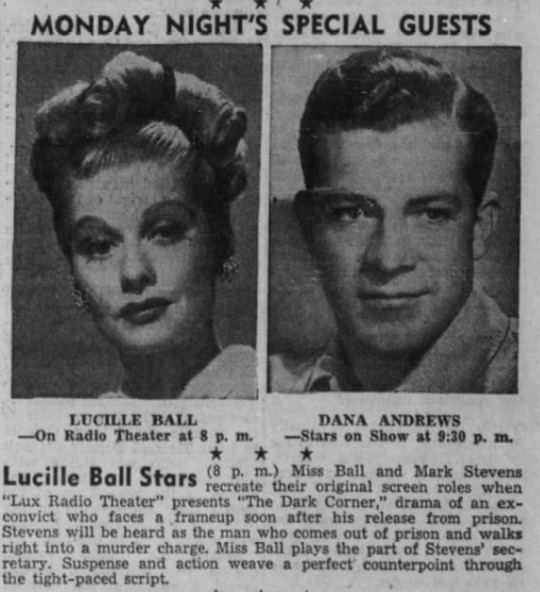
Directed by Fred MacKaye with musical direction by Louis Silvers and sound effects by Charlie Forsyth
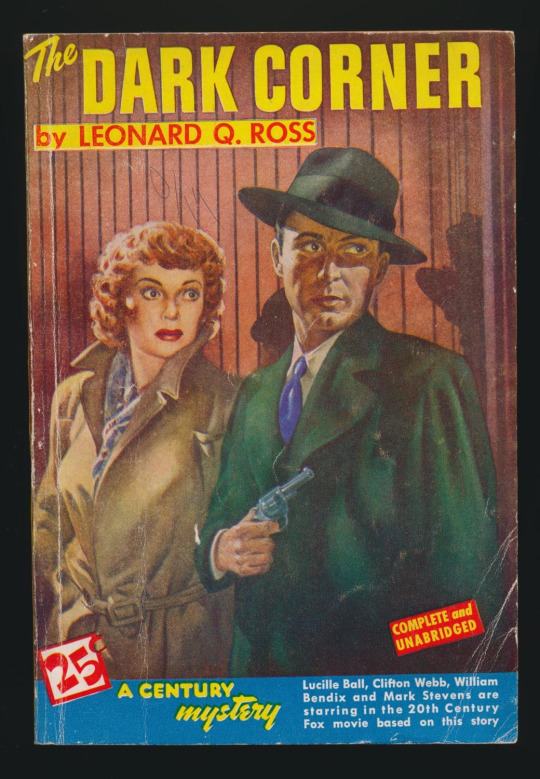
Adapted for radio by Sanford Barnett from the screenplay by Jay Dratler and Bernard Schoenfeld based on the book by Leo Rosten.

It was based on the 20th Century Fox motion picture of the same name released on May 8, 1946.
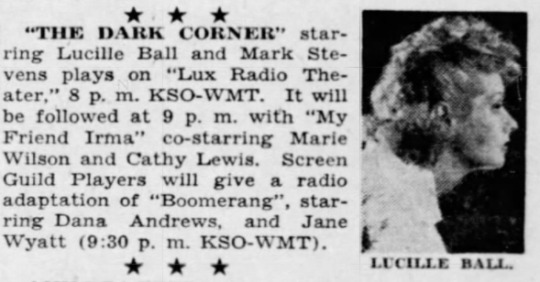
In later years, Lucille Ball was vocal about hating the experience of shooting The Dark Corner. Director Henry Hathaway's bullying reduced Ball to stuttering on set, at which point Hathaway accused her of being inebriated. At the time, Lucille Ball was suing to get out of her contract with MGM. As a result, MGM loaned her to Fox for this picture, which included a significant pay cut.

Lux Radio Theatre (1935-55) was a radio anthology series that adapted Broadway plays during its first two seasons before it began adapting films (”Lux Presents Hollywood”). These hour-long radio programs were performed live before studio audiences in Los Angeles. The series became the most popular dramatic anthology series on radio, broadcast for more than 20 years and continued on television as the Lux Video Theatre through most of the 1950s. The primary sponsor of the show was Unilever through its Lux Soap brand.
CAST

Lucille Ball (Kathleen Stewart) was born on August 6, 1911 in Jamestown, New York. She began her screen career in 1933 and was known in Hollywood as ‘Queen of the B’s’ due to her many appearances in ‘B’ movies. “My Favorite Husband” eventually led to the creation of “I Love Lucy,” a television situation comedy in which she co-starred with her real-life husband, Latin bandleader Desi Arnaz. The program was phenomenally successful, allowing the couple to purchase what was once RKO Studios, re-naming it Desilu. When the show ended in 1960 (in an hour-long format known as “The Lucy-Desi Comedy Hour”) so did Lucy and Desi’s marriage. In 1962, hoping to keep Desilu financially solvent, Lucy returned to the sitcom format with “The Lucy Show,” which lasted six seasons. She followed that with a similar sitcom “Here’s Lucy” co-starring with her real-life children, Lucie and Desi Jr., as well as Gale Gordon, who had joined the cast of “The Lucy Show” during season two. Before her death in 1989, Lucy made one more attempt at a sitcom with “Life With Lucy,” also with Gordon.
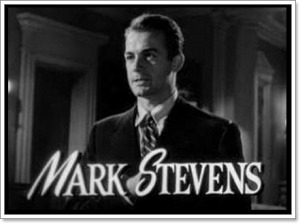
Mark Stevens (Bradford Galt) reprises his role from the film version of The Dark Corner (1946). He became a contract player for Warners at $100 a week in 1943 but they darkened and straightened his curly ginger-colored hair and covered his freckles. At first he was billed as Stephen Richards, he later changed it to Mark Stevens at the suggestion of Darryl F. Zanuck when he switched to 20th Century-Fox. He died in 1994 at age 77.

Joseph Kearns (Ralph Wickett) appeared on “I Love Lucy” as the psychiatrist in “The Kleptomaniac” (ILL S1;E27) and later played the theatre manager in “Lucy’s Night in Town” (S6;E22). His most famous role was as Mr. Wilson on TV’s “Dennis the Menace” (1959). When he passed away during the show’s final season, Lucy regular Gale Gordon took over for him, playing his brother.
In the film, the character was named Hardy Cathcart and was played by Clifton Webb.
Norma Jean Nilsson (Little Girl at the Boarding House) was a child actress who left Hollywood at age 19 after appearing in 16 films and television shows.
In the film, the character carries a slide whistle, which is not used here. She was played by Colleen Alpaugh.
Wally Maher (Fred Foss aka Stauffer) was born on August 4, 1908 in Cincinnati, Ohio. He was known for Mystery Street (1950), The Reformer and the Redhead (1950) and Hollywood Hotel (1937). He was married to Molly Bruno. He died on December 27, 1951.
In the feature film, the role was played by William Bendix, who would go on to fame as the title character in TV’s “The Life of Riley.”
Dan O'Herlihy (Anthony Jardine) was an Irish-born actor nominated for an Oscar in 1954 for Robinson Crusoe. In 1960 he made an appearance on Desilu’s “The Untouchables.” He was in two of the RoboCop movies. He died in 2005 at age 85.
In the feature film, the role was played by German-born actor Kurt Krueger.
Fay Baker (Mari Wickett) was born on January 31, 1917 in New York City as Fanita Baker Schwager. She was known for Notorious (1946), The House on Telegraph Hill (1951) and Deadline - U.S.A. (1952). She died on December 8, 1987.
In the feature film, the role was taken by Cathy Downs, making her first credited screen appearance.
ENSEMBLE
Trude Marson was seen in uncredited roles in four films from 1937 to 1947.
Noreen Gammill started her screen career as the voice of Catty the Elephant in Disney’s Dumbo (1941). She made two background appearances on “The Andy Griffith Show” (1963 and 1964), filmed on the Desilu backlot.
William Johnstone is probably best remembered as Judge Lowell on the long-running daytime drama “As The World Turns”. Prior to that he worked extensively in radio and took over the role of Lamont Cranston on "The Shadow" playing opposite Agnes Moorehead when Orson Welles left the series.
Janet Scott was a regular background voice on “Lux Radio Theatre” with dozens of episodes to her credit from 1937 to 1955.
Lois Corbett was married to Don Wilson of “The Jack Benny Program” and as such did more than a dozen episodes of the television shows with him from 1954 to 1964.
Edward Marr was seen in The Affairs of Annabel with Lucille Ball in 1938. He was also in two Bob Hope TV specials with Hope and Ball in 1966 and 1970.
Stanley Farrar was seen on “I Love Lucy” in “Home Movies” (ILL S3;E20) and “Staten Island Ferry” (ILL S5;E12). He on “The Lucy Show” in “Lucy and Arthur Godfrey” (TLS S3;E23) and “Lucy Meets Danny Kaye” (TLS S3;E15).
Herb Butterfield was born on October 28, 1895 in Providence, Rhode Island. He was known for The Halls of Ivy (1954), The House on Telegraph Hill (1951) and Shield for Murder (1954). On radio, he portrayed the Commissioner on NBC 's "Dangerous Assignment" (1949-53) and Clarence Wellman on "The Halls of Ivy" (1950-52). He died on May 2, 1957
Cliff Clark was seen with Lucille Ball in Her Husband’s Affairs (1947), Miss Grant Takes Richmond (1949), and The Fuller Brush Girl (1950).
OTHERS

William Keighley (Host and Producer) was the director of nearly 40 feature films between 1932 and 1953. His film The Adventures of Robin Hood (1938) was selected for the National Film Registry by the Library of Congress as being culturally significant.
Dorothy Lovett (Commercial Spokeswoman as Libby Collins, Hollywood Reporter) appeared as Meta Bauer on radio’s “The Guiding Light" (1945-47) and as Toni Sherwood in "The Adventures of Rocky Jordan". She did three films with Lucille Ball from 1939 to 1941.
Betty Ann Lynn (Herself, Act Two Intermission Guest) is best known for playing Thelma Lou on “The Andy Griffith Show” (1961 to 1965) which was filmed on the Desilu back lot.
John Milton Kennedy (Announcer) was the announcer of all 35 episodes of “The Loretta Young Show” from 1954 to 1955.
ACT ONE

William Keighley introduces the program, noting that many years earlier, director Fred Kohlmar saw a titian-haired young model who had great possibilities - Lucille Ball. He later had the privilege of presenting her in the film version of The Dark Corner. After a mention of Lux Toilet Soap, the program begins.
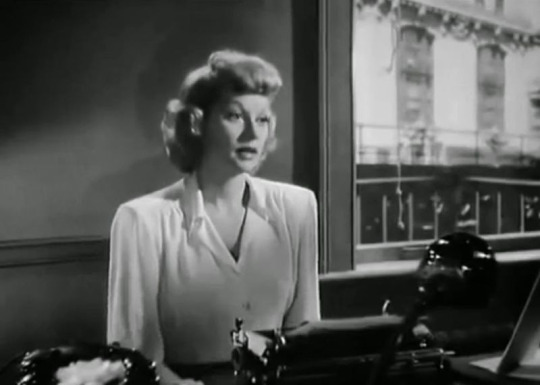
The action opens in a New York City office building on a sultry summer afternoon. Police detective Reeves visits the Offices of Bradford Galt, Private Investigator and speaks to his secretary, Kathleen Stewart.
Galt enters and Reeves wonders why Galt didn’t notify him that he moved offices after his prior unpleasantness. Galt asks Kathleen to have dinner with him. After dinner, Galt asks her to go dancing but she’s wise to his advance. As they walk down the street, they realize that they are being followed.
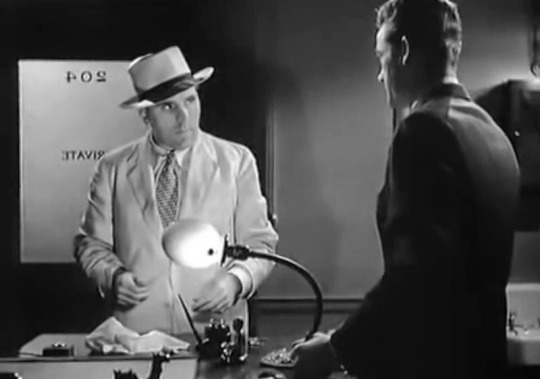
Kathleen takes a cab back to the office, while Galt confronts the pursuer at gunpoint, taking him back to his office for questioning. He says his name is Fred Foss, and that he’s also a private detective. Galt doesn’t believe him and decides to beat the truth out of him.

After some roughing up, Fred discloses that he is being paid to tail Galt by Anthony Jardine. In the tussle, some ink spills on Foss’s white suit. He lets Foss leave. Kathleen was supposed to tail Foss after he left the office, but he tricked her and got away.
Back at his rooming house, Foss uses the hall telephone to call art gallery owner Ralph Wickett, and his ink-stained suit is noticed by a Little Girl neighbor.
At a party for his third wedding anniversary, Wickett hangs up and is greeted by Jardine, a lawyer. Mrs. Lucy Wilding takes Jardine aside pretending to ask legal advice, but it is revealed that he is blackmailing her.
Meanwhile, Galt confides in Kathleen about his past. Jardine is trying to kill Galt because he was a former partner that Galt confronted about his blackmailing female clients. Now Jardine wants to finish the job.
Mari Wickett, Ralph’s wife, is having an affair with Anthony Jardine. She wants to run away with him. At the same time, Galt is headed there to settle the score.
End of Act One

A Lux commercial break takes the form of a story from Libby Collins, Hollywood Reporter. She says she saw Universal’s The Lost Moment starring Robert Cummings and Susan Hayward. Libby says she was on location when they filmed the big fire scene, the biggest fire ever done on a sound stage. She says that she and Susan Hayward washed the soot off their faces with Lux Toilet Soap!
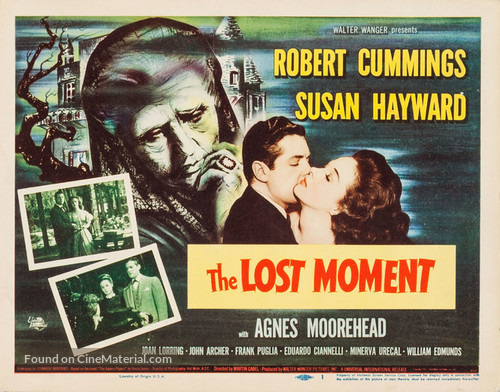
At the time of the broadcast, The Lost Moment was still two weeks from being released. It opened in cinemas on November 27, 1947. The story is set in Italy, so the cast included Edward Ciannelli, who played pizzeria owner Mr. Martinelli in “Visitor from Italy” (ILL S6;E5) and Saverio LoMedico who played the Rome hotel bellboy in “Lucy’s Italian Movie” (ILL S5;E23). The film was not a box office success.
ACT TWO

An hour has past since the end of Act One and Galt is at Jardine’s door. Galt threatens Jardine, who denies tailing him.The two fight while Mari is hiding in the other room. After Galt leaves, she convinces him to run away with her.
At the Gallery, Wickett is visited by Foss. It is clear Wickett is setting up Jardine to take the fall when he has Galt killed. Foss calls Galt to betray Jardine for a price. Galt suggests a one-on-one meeting at his apartment - 904 West 52nd, apartment 307 at 8pm sharp. Wickett will send Jardine to Galt’s apartment at 7:30pm.
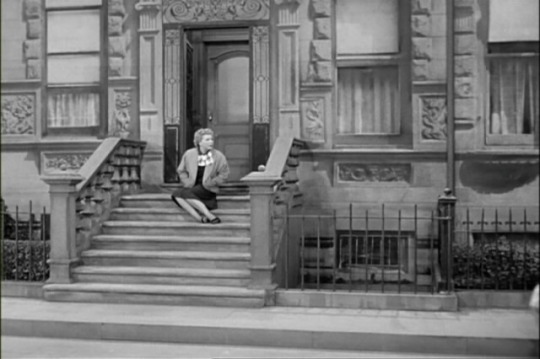
In reality, there is no such address. West 52nd Street in New York City ends at the the 600s block. This is similar to the Ricardo and Mertz apartment building. 623 East 68th Street, which, if real, would be in the East River!
Kathleen and Galt are supposed to meet at the movies, but he doesn’t show so he goes to his apartment at 8:30. Galt opens the door and reveals that Jardine is dead. Galt was ambushed with and knocked out with ether. He woke up to find Jardine’s body bludgeoned by the fireplace poker. Galt realizes he was set up.
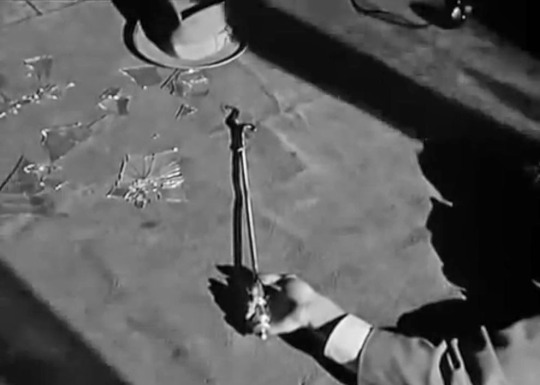
Later, Galt meets Kathleen at her apartment. He couldn’t find Foss and doesn’t know where to look next.
Wickett reminds Mari that they are due at the Kinsglsey’s that night, but she begs off. He strongly hints that he knows that Mari is stepping out on him and looking to run off.
Galt suddenly realizes that Foss would have to have his white suit cleaned, so he is determined to search all the cleaners for the suit and get his address.
Foss phones Wickett, and the Little Girl is there to overhear his conversation. Foss makes a plan to meet Wickett on the 31st floor of the Grant building.
Galt and Kathleen are about to give up on the search for the suit when a cleaner comes through. They get his address and trace Foss to the rooming house where he lives. His name turns out to be Stauffer, not Foss. The landlady reports that he moved out an hour ago and doesn’t know where he went. But the Little Girl does - and spills the beans for a quarter! Galt and Kathleen head for the Grant Building.
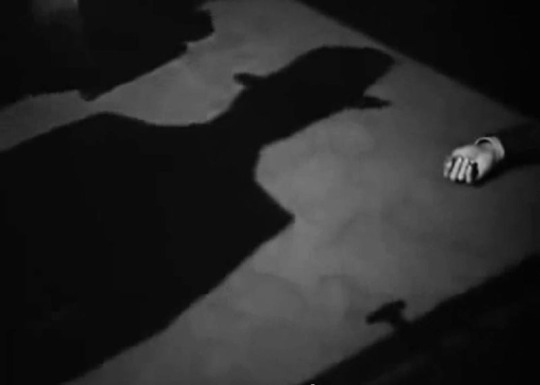
End of Act Two
In the break, Keighley interviews Fox contract player Betty Ann Lynn, who saw filming of Daryl F. Zanuck’s Gentleman’s Agreement starring Gregory Peck and Dorothy McGuire in a “very unusual picture”.

Gentleman’s Agreement premiered on November 11, one day after this broadcast, in both New York City and Chicago. It dealt with anti-Semitism and went on to win three Oscars, including Best Picture. The cast included Lucycom alumni Mike Lally, Shep Houghton, Roy Roberts, and Amzie Strickland in uncredited roles. Betty Ann Lynn says that she also likes to watch the filming of a costume picture like The Foxes of Harrow starring Rex Harrison and Maureen O’Hara, who had 26 costumes made just for her. She notes that O’Hara has a Lux complexion.

The Foxes of Harrow was released September 13, 1947. "Lux Radio Theater" broadcast a sixty minute radio adaptation of this movie on December 6, 1948, with Maureen O'Hara reprising her movie role. The movie was the screen debut of William Schallert, who did several episodes of “The Lucy Show.” O’Hara and Lucille Ball became lifelong friends after their 1940 film Dance, Girl, Dance. Like Gentleman’s Agreement, The Foxes of Harrow also features Roy Roberts, who went on to play bank president Mr. Cheever on “The Lucy Show.”
ACT THREE
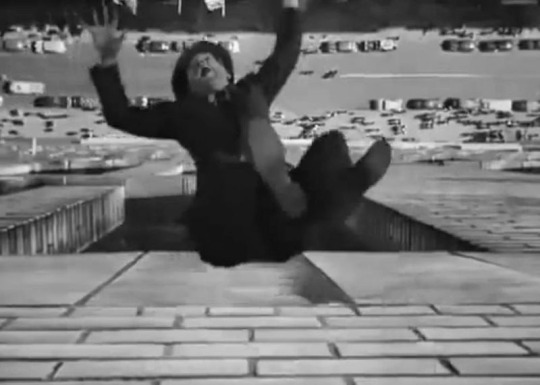
Kathleen and Galt rush to the Grant Building, where Mr. Wickett is about to settle accounts on a remote fire escape. Foss / Stauffer brings proof that Jardine is dead but Wickett throws him from the fire escape to his death.
Galt and Kathleen witness the whole incident from the street, as does the cab driver who was waiting for Foss / Stauffer. Thinking fast, Galt steals the cab which still contains Foss’s luggage. Later, we hear that the bags were only full of clothes. Kathleen urges him to keep thinking.
Kathleen suddenly remembers that the Little Girl mentioned galleries. They put the pieces together and all evidence leads them to the Wickett Galleries. Galt heads there and questions the clerk. Under the guise of buying a painting, Galt inquires about meeting Mr. Wickett, and the clerk departs. Mari comes in the side door, and Galt tells her that Anthony Jardine has been murdered. She faints. Wickett comes in and when Galt tells him the truth, Ralph locks him in the gallery vault. Mari has revived and overhears Ralph’s threats, holding a gun on him. She shoots her husband dead.

Kathleen has tipped off the police, who only want to charge him with stealing a taxi cab. Kathleen asks if he can be booked at another time because they have a date at the City Hall - to get married.
End of Story
As a curtain call, Keighley chats with Lucille Ball and Mark Stevens. He congratulates Ball on the success of her stage show, Dream Girl, a play she says she will do again in San Francisco. When Keighley asks how Lucille’s busy schedule and that of her husband Desi Arnaz’s leave any time for a personal life, Ball says that they will be playing in San Francisco at the same time.

In June 1947, Lucille Ball performed at New Jersey’s McCarter Theatre in Dream Girl, a play by Elmer Rice. It also played Brooklyn, Detroit and Boston.

The San Francisco production opened just a week after this radio telecast. As Ball states, Desi Arnaz was also in San Francisco at the time, playing in the Rose Room of the Palace Hotel, a fact that was advertised in the Dream Girl program. During the Los Angeles engagement in January 1948, Ball fell ill and had to withdraw. Although she love performing on stage, her radio career and then television success did not allow her to return to the footlights until 1960.

Lucy notes that like many other busy stars, she owes her good complexion to Lux Soap!
Turning to Mark Stevens, Lucille notes that he will play an FBI man in his next project at Fox, with Keighley as director.

Although the film’s title is not mentioned, they are referring to The Street With No Name, which won’t be released until June 1948. Stevens plays Gene Cordell aka George Manley, a covert FBI agent who infiltrates a ruthless gangster mob. "Lux Radio Theater" broadcast a 60-minute radio adaptation of the movie on January 31, 1949 with Mark Stevens reprising his film role.
Keighley notes that next week “Lux Radio Theatre” will present Jane Wyman and Ronald Reagan in Nobody Lives Forever.

The Warner Brothers picture Nobody Lives Forever was released on November 1, 1946. It originally starred John Garfield and Geraldine Fitzgerald in roles taken on radio by Reagan and Wyman, who were husband and wife at the time. Of course, Reagan left Hollywood for a grander stage, first in California as Governor, then as President of the United States. He bestowed Lucille Ball with The Kennedy Center Honor in 1986.
A public service announcement asks housewives to salvage kitchen fats and turn them in at their local butcher for cash!

These were used to make supplies for wartime, such as ammunition and weapons.
Announcer Kennedy notes that Mark Stevens appeared through the courtesy of 20th Century Fox, producers of Forever Amber.

Forever Amber is a 1944 romance novel by Kathleen Winsor set in 17th-century England. It was made into a film in 1947 starring Cornel Wilde, who appeared in “The Star Upstairs” (ILL S4;E25). When “Lucy Writes A Novel” (ILL S3;E24), Ethel jokes about finding Lucy’s hidden manuscript and burning it: “We pulled down the kitchen blind and changed the name of your novel to 'Forever Ember.'”
‘DARK’ TRIVIA

In a September 1985 episode of “Remington Steele,” a character played by Stephen Dillane has the name Bradford Galt! The stories, however, are not otherwise connected.
In both the film and the radio show, Fred Foss gives his phone number as CH-elsea 4-43510. However, according to the Manhattan phone book for 1946, there were only CH-elsea 2 and CH-elsea 3 exchanges. Real phone numbers were rarely used in film or television.

When television began to supplant radio, “The Lux Video Theatre” was introduced. It was seen from 1950 to 1959. Initially, the show was a thirty-minute weekly show featuring live stage plays, but when it moved to NBC in August 1954, the show was extended to sixty minutes. As on radio, the programs were then primarily adaptations of motion pictures. The host would introduce each act, and would conduct an interview with the stars at the end of the play. Of the cast of this radio version of The Dark Corner:
William Keighley directed an episode in 1951.
Mark Stevens did an episode in 1955.
Dan O’Herlihy did five episodes.
Joseph Kearns did three episodes.
The character name Ralph Wickett replaced Hardy Cathcart for the radio show. It is likely that they could no longer get legal clearance to use the name Hardy Cathcart, necessitating the change.
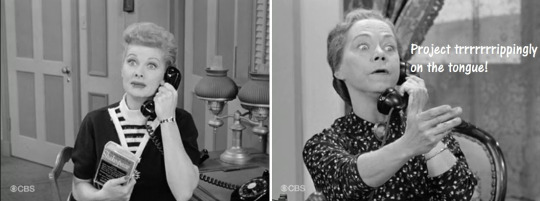
The film featured Ellen Corby as a maid, a role not in the radio drama. Corby went on to be seen as Lucy Ricardo’s high school acting teacher and in several small roles on “The Lucy Show” before her best-loved role of Grandma on “The Waltons.”

The film also features background work by Sam Harris, who did 15 films with Lucille Ball, in addition to multiple episodes of “I Love Lucy” and “The Lucy Show” as well as Harold Miller, who did eight films with Lucy and two episodes of “I Love Lucy”.

The film is available on DVD complete with DVD commentary and original trailer.

#The Dark Corner#Lucille Ball#Mark Stevens#Lux Radio Theatre#Radio#1948#Joseph Kearns#William Keighley#1947
5 notes
·
View notes